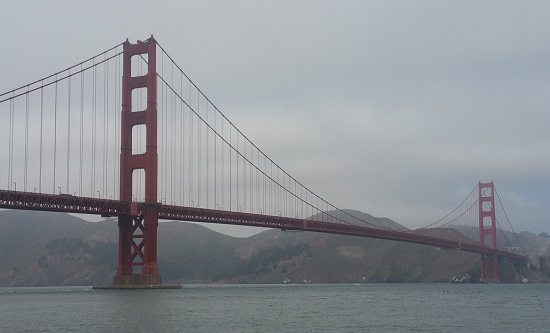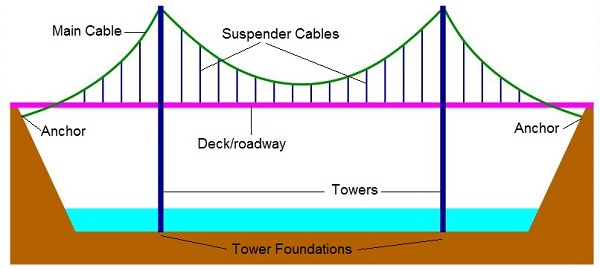
The Golden Gate Bridge
I enjoy looking for evidences of the Creator imprinted on his creation when I travel. This past summer we had the opportunity of visiting San Francisco where we saw the awe inspiring Golden Gate bridge and I snapped the above picture. I was also reminded of the Creator – in an indirect way. Obviously God didn’t directly build the bridge – but the bridge is a reminder of the design inherent in His creation. Let me explain. It is abundantly evident that the Golden Gate bridge is intelligently designed. But beyond that, not only is it intelligently designed, it’s clear it is also irreducibly complex. And irreducible complexity is an undeniable evidence of intelligent design..
Michael Behe introduced the concept of irreducible complexity in his book “Darwin’s Black Box, and defined it this way:
“By irreducibly complex, I mean a single system composed of several well-matched, interacting parts that contribute to the basic function, wherein the removal of any one of the parts causes the system to effectively cease functioning. An irreducibly complex system cannot be produced directly (that is by continuously improving the initial function, which continues to work by the same mechanism) by slight, successive modifications of a precursor system, because any precursor to an irreducibly complex system that is missing a part is by definition nonfunctional.”[1]
Michael Behe
Irreducibly complex biological systems – with their multiple intricate parts – must fit and work together perfectly from the beginning. They cannot not wait for the various parts to evolve separately. By definition and by function – if even a single part is missing or non-functional, then the entire system fails.
Irreducible complexity is devastating to Darwinian theory because there can be no small steps up mount improbable, no process that could put the system together, and even the punctuated jumps of punctuated equilibrium are insufficient for the construction and assembly of the various parts of an irreducibly complex system. The purposelessness and randomness of Darwinism simply precludes it. Indeed Darwin himself recognized that if a system can’t be built by small successive changes, it proves his theory false:
“If it could be demonstrated that any complex organ existed which could not possibly have been formed by numerous, successive, slight modifications, my theory would absolutely break down.”[2]
Charles Darwin
Thus irreducibly complexity drives a stake through the heart of Darwinian theory because whenever such a system is found – its very existence testifies that neither classical nor neo-Darwinian evolution can be true.
Behe uses the concept of a mouse trap with its five main components to demonstrate the concept of irreducible complexity. Here, I will use the concept of the suspension bridge – such as the Golden Gate bridge – to do so. Consider the individual components of a suspension bridge:

There are 6 main components: The main (twin) cable(s), the vertical suspender cables, the towers, the deck or roadway, and the anchors and the foundation. If any of these parts is removed or is never assembled in the first place, the bridge will fail. It’s easy to see how removing either the main cables, suspender cables, towers or deck will cause the entire structure to fail. But consider – what’s holding up the towers? What’s keeping the main cable from pulling free? The entire weight of the bridge is pressing down on the towers. Thus to support all that weight, in the north tower alone of the Golden Gate bridge “the huge girders that would support the north tower were embedded in 98,000,000 lbs of concrete.”[3] The towers were not just casually sunk into the ground. And the anchors which support the main cables are equally as important:
“The cable looks like 1 large wire. It’s 3 feet in diameter, but it’s actually 27,572 individual wires each the size of a large pencil lead if you wish. Each of those is put into bundles. There’s 61 bundles. Each bundle has a little over a million pounds of force on it.”[4]
Dennis Mulligan, Chief Engineer, Golden Gate Bridge
That’s at least 61 million pounds of force the anchors must keep securely attached to the ground on each end of each main cable. Obviously the cables were not just casually dropped into the ground either. Clearly such a structure as a suspension bridge does not occur naturally in nature. You may find a tree falling to bridge the gap between two facing cliffs, or you may come across a natural arch bridge formed by a river wearing away the underside of a rock. But neither of those are suspension bridges, and neither of those are irreducibly complex.
Not only is a suspension bridge irreducibly complex, but the individual components themselves are also highly complex and carefully designed to do their jobs. Now suppose we were to find an organ in the human body that is similarly designed – what would we conclude? Obviously we must conclude that just as the Golden Gate bridge is irreducibly complex and clearly designed; such an organ would likewise be irreducibly complex and clearly designed. Well there is such a organ. And while it has been known about for sometime, it’s been recently reclassified from being merely a collection of tissues to a full fledged organ. It’s the mesentery.
“The mesentery is a double fold of peritoneal tissue that suspends the small intestine and large intestine from the posterior abdominal wall.”[5] As a suspension bridge supports a deck or road above a body of water, the mesentery (picture here) “…plays a key structural role in keeping internal organs suspended above the pelvis and away from entanglement with nearby blood vessels.”[6]
And just as the vertical suspender cables don’t connect directly to the weight bearing towers in a suspension bridge but rather to a main cable, neither does the mesentery connect directly to its weight bearing system: the skeletal system. Rather it is supported by the posterior abdominal wall. And the posterior abdominal wall then attaches to various places of the skeleton – anchored with special connecting tissue.[7]
So we see the mesentery system has an analog to all the components of a suspension bridge: Main cable (posterior abdominal wall), suspender cables (mesentery tissue), deck/roadway (suspended organs – small and large intestine), towers (skeletal system), anchors and foundation (special connecting ligaments).
If you agree that a suspension bridge is not a naturally occurring phenomenal, then you must also agree that the mesentery, which physicians just recently recognized to be part of one large system, must also be part of one large system that is not naturally occurring. That system – the human body – is irreducibly complex and thus clearly designed. Of course biologists can point out many irreducibly complex systems in the body. Behe in his book points to the Blood clot cascade as another irreducibly complex system operating in the body. But there’s not (to my knowledge) a natural analog to the clot cascade which is easily recognizable and understandable. Suspension bridges on the other hand, in their beautiful, elegant design are easy to understand, easy to picture how catastrophic the removal of even one component would be, and thus are easy to understand that they are clearly irreducibly complex. Thus a system that operates like a suspension bridge is easily understood as a powerful argument for Intelligent Design.
The mesentery may not be as glamorous as a suspension bridge – but by way of analogy it makes all the same points regarding irreducible complexity. Indeed it is likely to score more points for intelligent design as more is learned about it. But even now we welcome the new discovery of the mesentery as a single organ as another testament to the intelligent design of our Creator God, and we can be reminded of his genius when we see the beauty in the irreducibly complex Golden Gate bridge (and other suspension bridges).
Duane Caldwell | October 11, 2018 | Printer Friendly Version
Follow @duanecaldwell
Notes
1. Michael Behe, Darwin’s Black Box – The Biochemcial Challenge to Evolution, New York: Freepress, 1996, p.39
Back
2. Charles Darwin, (1872) Origin of Species, 6th ed. (1988), New York University Press, New York, p.154;
ref. from Behe, Darwin’s Black Box, p. 39
Back
3. Modern Marvels – episode, “Golden Gate Bridge” History Channel Documentary, 1994 & 2005
Back
4. Dennis Mulligan, Chief Engineer, Golden Gate Bridge, ref. from Modern Marvels – episode, “Golden Gate Bridge” History Channel Documentary, 1994 & 2005
Back
5. “The Mesentery”, TeachMeanatomy.info, accessed 10/6/2018, http://teachmeanatomy.info/abdomen/viscera/mesentery/
Back
6. Jessica Yuan, “New Human Organ Overturns a Century of Medical Knowledge”, Quarkmag.com, Jan9, 2017, https://quarkmag.com/meet-your-new-organ-in-the-human-body-bd254fe6147a
Back
7. Regarding the attachments of the Poterior Abdominal wall:
“It It originates from the iliac crest and iliolumbar ligament. The fibres travel superomedially, inserting onto the transverse processes of L1 – L4 and the inferior border of the 12th rib.”
“The Posterior Abdominal Wall”, TeachMeAnatomy.info, accessed 10/6/2018, https://teachmeanatomy.info/abdomen/muscles/posterior-wall/
Back
For further References, see also:
“Why new human organ called mesentery is so important”, Tech Insider via YouTube, Jan 8, 2017,
https://www.youtube.com/watch?v=ru2–3NHQiE
“You Now Have A New Organ: Meet The Mesentery!”, Seeker via Youtube Jan 6, 2017,
https://www.youtube.com/watch?v=KVoiR5I7VN0
